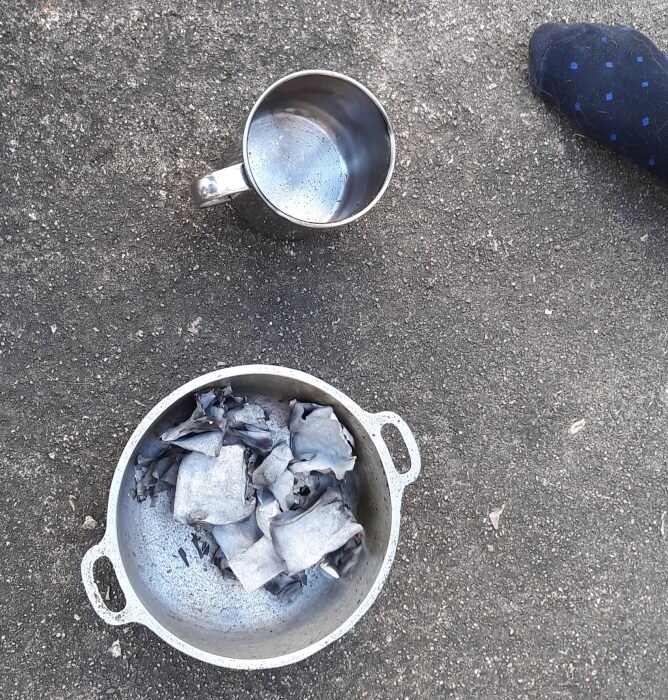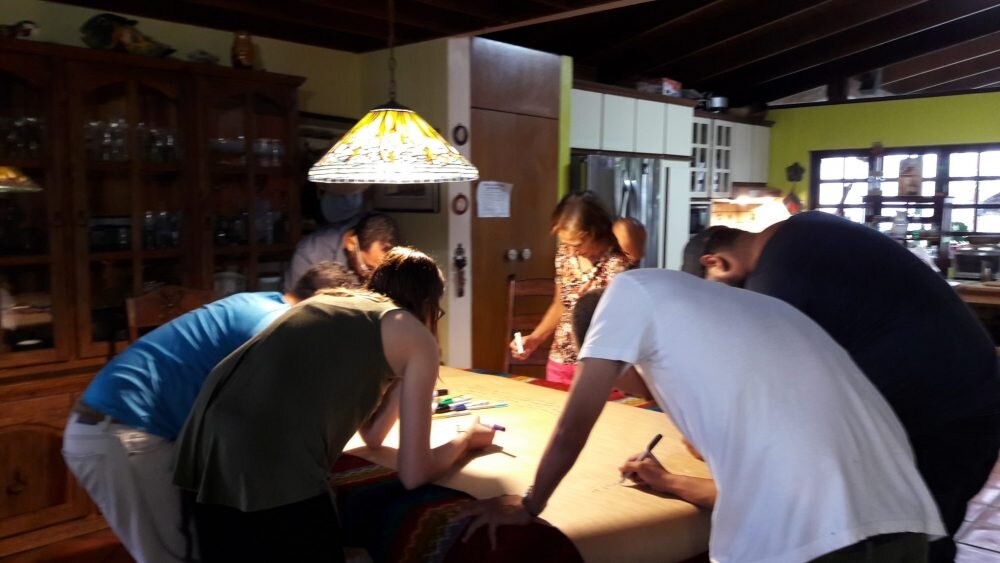Puerto Rico: Helping Those Who Help Others
Cover: Artist in front of her mural destroyed by hurricane Maria, picking up new material for the art of the future. Puerto de Tierra, San Juan, Puerto Rico, January 2018 (Photo E. Horbaty)
By Elsbeth Horbaty *
In January 2018, I spent three weeks in Puerto Rico supporting groups of women and men who have been working ceaselessly to help their communities recover after two major hurricanes – Irma and Maria – devastated the Caribbean island last September.
Irma and Maria (Photo: Washington Post)
At home in Zurich in November, I had been deeply moved by a New York Times report on the worsening mental health of many people impacted by the devastation, particularly the large number of exhausted volunteers.
I hoped that, with my background as a professional in development aid and trauma recovery, I could share some ideas with these groups to help them carry on their invaluable work with renewed focus and strength. I immediately started making contacts on the island and preparations for my visit there.
When I arrived at the beginning of the year, 50 percent of the island was still without power. The hurricane had killed over 1,000 people (the exact figure is still a matter of discussion), destroyed or damaged thousands of houses, wreaked havoc on its physical infrastructure, and flattened trees and crops.
Every person in Puerto Rico was affected to one degree or another. US aid was coming in, but far too slowly and in amounts way below what the local population and authorities were expecting.
It was clear to all – including me – that it would be a very long time before the island would fully recover from the disaster. Sustaining the recovery would be a major challenge.
People told me that Hurricane Maria had changed the course of the island’s history – that the hurricanes highlighted the worst and the best of their society. From one moment to the next, the island’s economic and social crises, and the fraught political relationship with the US, were laid bare for all to see.
But the world also witnessed the best of the Puerto Rican spirit: complete strangers reached out to help one another, and neighbors and office workers organized spontaneously to provide help where it was needed. I saw these volunteer efforts being sustained even as I left weeks later.
I met with several groups that had started supporting their neighbors as soon as the winds died down. They had checked on the situation throughout their communities and helped track down missing people and pets. Soon these groups began clearing the rubble of damaged homes, fallen branches and trash from the streets.
Suddenly all the memories are coming back: In words, in drawings and in symbols these women are writing down details of the incredible strengths they developed in the aftermath of hurricane Maria. Artist collective Taller Malaquita, Santurce, Puerto Rico
The group that requested my support – led by six young women from the Taller Malaquita in San Juan – had quickly converted their large arts center into a relief warehouse. The roof was leaking but, luckily, the electricity was restored soon after Maria passed. They provided a place where cell phones could be charged and where food and clothes could be stored for distribution to hardest-hit nearby communities.
After a few weeks, they began fanning out to parts of the countryside unreached by relief efforts.
From my previous work with traumatized people, I knew that in an emergency people can summon up enormous strength to help others, but after some weeks, feel exhausted and depleted. Working under enormous stress starts to become a daily routine and returning to normal life seems impossible.
I organized a total of seven workshops for groups of artists, health workers, academics and public employees. The workshops offered these groups a welcome break from the endless work and the space to reflect on what had happened
I worked with nearly 80 persons in groups and individually, using a technique called somatic experiencing (SE®). With this approach, people focus on their strengths and inner resources to discover new orientation and resilience.
During the workshops, the participants used drawings, words and symbols to record all they had done from the very first day after the hurricane struck until mid-January 2018. Then they were invited to include the sensations that had been awakened in their bodies. Gradually these exercises led them to a feeling of satisfaction for having served their neighbours.
We then took time to honor all that was lost during those difficult days. During the short ritual, no one would speak, but rather write down a few words on a paper: loss of human lives, loss of pets, missing people who left the country (around 250,000 in the first four months), injuries, illnesses and losses of material possessions. All these little papers containing so much loss and hurt were then burnt and the ashes used as fertilizer on nearby plants.
After a period of silence, the group came back together to discuss their recommendations on how to continue. They learned how to become more resilient. They worked out what the strengths and contributions of each person could or will be and on what networks they could rely for support going forward.
Details of difficult moments San Juan, Puerto Rico, January 2018
(Photo E. Horbaty)
In the end, participants expressed their sense of greater clarity about the direction of their work, feeling stronger and having a greater sense of working as a group. “I know now where we as a group are heading, and I feel better prepared to confront the future”, one of the artists said.
After returning to Switzerland, I began preparations for another project to work with artists and the local communities of San Juan. The idea is to set up memorials in the form of murals painted by local artists in eight different locations in the capital city to celebrate the help people gave each other during those difficult months in late 2017.
What have we learned, where do we go from here? What can I contribute? What do we
need? What is our network? Community employees San Juan, Puerto Rico January 2018 (Photo E. Horbaty)
By sharing memories, by honoring the helpers, and reflecting on lessons learned through adversity, the community can then realize their own strengths and encourage themselves and others to become more resilient in the face of future emergencies.
*Elsbeth Horbaty is a Zurich-based development aid and trauma recovery professional, and a good friend of Rain Barrel.





